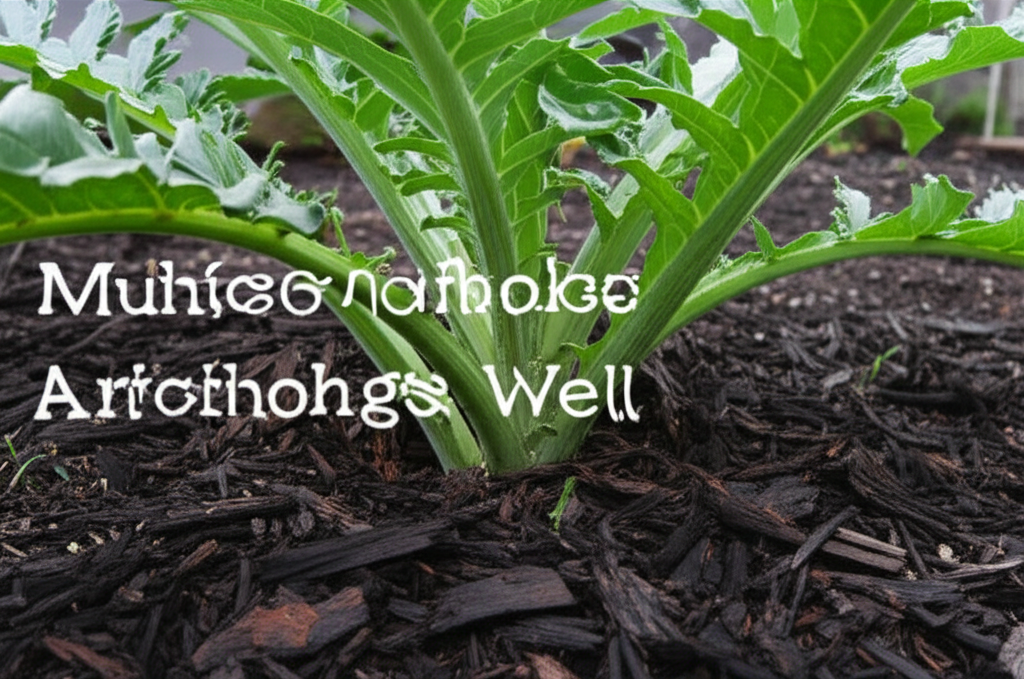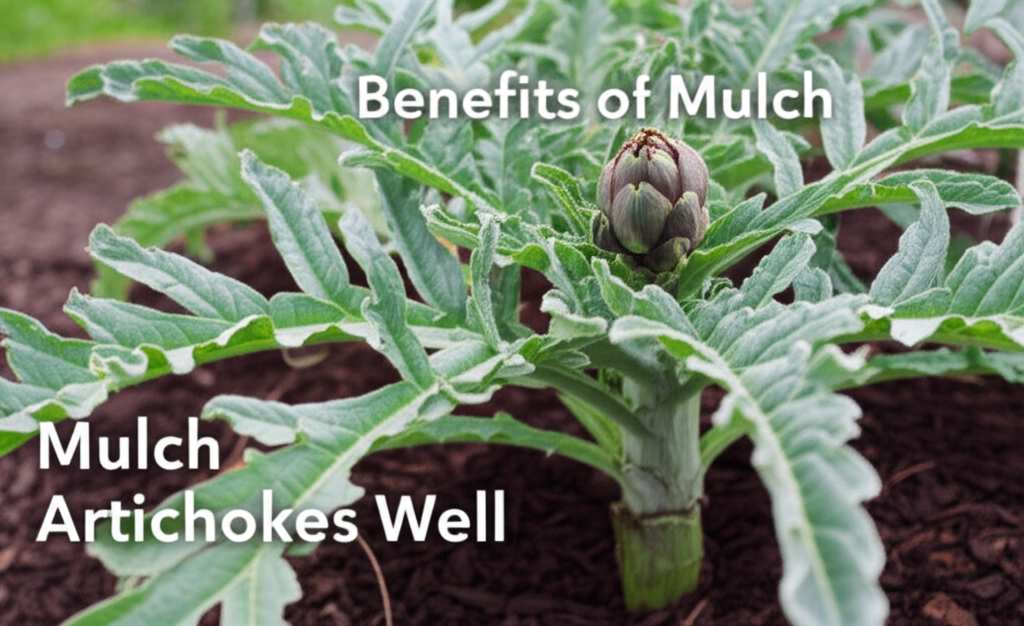Why Mulch is Essential for Globe Artichokes
Growing globe artichokes (Cynara cardunculus var. scolymus) is a rewarding endeavor, often yielding delicious, tender edible flower buds. However, to achieve robust plants and a generous harvest, understanding the role of mulch is paramount. Mulching is not merely an aesthetic choice in the vegetable garden; it’s a strategic practice that significantly impacts plant health, soil quality, and overall yield. For globe artichokes, a plant that thrives in specific conditions and can be susceptible to environmental stresses, proper mulching acts as a protective blanket, a moisture regulator, and a nutrient provider.
Globe artichokes are native to the Mediterranean region, a climate characterized by hot, dry summers and mild winters. Mimicking these conditions in your garden is key to success. Mulch plays a crucial role in replicating the benefits of their natural environment. It helps to retain soil moisture, which is vital for these thirsty plants, especially during periods of drought or high heat. It also suppresses weeds, reducing competition for water and nutrients. Furthermore, mulch can insulate the soil, protecting the artichoke’s sensitive root system from extreme temperature fluctuations, both hot and cold.
Understanding the Globe Artichoke’s Needs
Before delving into the specifics of mulching, it’s beneficial to appreciate what globe artichokes require to flourish. These perennial plants can live for many years if provided with the right conditions. They prefer:
- Full sun: At least 6-8 hours of direct sunlight per day.
- Well-draining soil: Artichokes dislike waterlogged roots, which can lead to rot.
- Rich, fertile soil: They are heavy feeders and benefit from nutrient-rich compost.
- Consistent moisture: While they prefer well-draining soil, they also need regular watering, especially during their growth and flowering stages.
- Protection from extreme temperatures: While generally hardy, young plants and overwintering crowns can be damaged by severe frost.
These requirements highlight why mulching becomes such an indispensable part of artichoke cultivation. It directly addresses the need for consistent moisture, soil fertility, and temperature regulation.
Choosing the Right Mulch for Globe Artichokes

The effectiveness of mulching hinges on selecting the appropriate material. For globe artichokes, a combination of organic mulches is often recommended, as they provide the best all-around benefits.
Organic Mulches: The Top Choices
Organic mulches decompose over time, enriching the soil with valuable nutrients. This makes them particularly beneficial for heavy-feeding plants like artichokes.
- Straw: A classic and highly effective mulch. Straw, particularly wheat or oat straw (ensure it’s weed-seed-free), is excellent at retaining moisture, suppressing weeds, and breaking down to add organic matter to the soil. It’s also lightweight and easy to work with.
- Hay: Similar to straw, but hay often contains seeds from the grasses and legumes it was made from. If you use hay, be prepared for a higher weed population. For this reason, seed-free straw is generally preferred.
- Composted Leaves: Well-rotted leaves provide excellent soil conditioning and nutrients as they decompose. They also help retain moisture and suppress weeds.
- Wood Chips/Shredded Bark: These are longer-lasting mulches and are great for suppressing weeds and retaining moisture. However, they can sometimes tie up nitrogen in the soil as they decompose, especially if they are fresh or not fully composted. If using fresh wood chips, consider a nitrogen top-up for your artichokes.
- Compost: A layer of finished compost itself acts as an excellent mulch, directly feeding the soil and retaining moisture.
Inorganic Mulches: When and Why (Use with Caution)
While organic mulches are generally preferred for their soil-enriching properties, inorganic mulches have their place, albeit with some considerations for artichokes.
- Gravel or Pebbles: Can be used in very hot, dry climates to reflect heat and retain some moisture. However, they do not improve soil fertility and can make the soil warmer, which may not be ideal for artichoke roots in extremely hot regions.
- Plastic Mulch: Often used in commercial settings for weed suppression and moisture retention. However, it can overheat the soil and prevent beneficial microbial activity. It also doesn’t decompose, contributing to plastic waste. If used, ensure it’s a breathable fabric or consider removing it after the main growing season.
For the home gardener aiming for healthy, productive globe artichokes, the focus should primarily be on organic, decomposing mulches.
When to Apply Mulch Around Globe Artichokes
Timing is crucial for maximizing the benefits of mulching. Applying mulch at the wrong time can be less effective or even detrimental.
Spring Mulching: The Primary Application
The ideal time to apply mulch around established globe artichoke plants is in early spring.
- After the last frost: Wait until the danger of severe frost has passed, as the soil needs a chance to warm up.
- When the soil is moist: Apply mulch after a good watering or rainfall.
- Around established plants: Gently pull back any winter mulch or debris from the crown of the plant.
- Generous layer: Apply a thick layer, typically 3-4 inches deep.
This spring application prepares the plants for the summer heat and potential dry spells, while also suppressing the emergence of spring weeds.
Summer Top-ups: Maintaining Moisture
As the summer progresses and the plants grow vigorously, the mulch layer may thin out or break down.
- Check regularly: Inspect the mulch layer every few weeks.
- Replenish as needed: Add more mulch if the layer has significantly diminished or if the soil surface is becoming exposed.
- Avoid covering the crown: Always leave a small gap around the base of the plant to prevent rot and allow for air circulation.
Winter Mulching: Overwintering Protection
In colder climates, a protective layer of mulch is essential for the survival of globe artichokes over winter.
- After the first hard frost: Apply a thick layer (4-6 inches) of straw or shredded leaves after the plant has been cut back to about 6-8 inches from the ground.
- Cover the crown: This layer will insulate the crown and root system from freezing temperatures and frost heave.
- Remove in spring: Crucially, this winter mulch must be removed in spring once the danger of hard frost has passed to allow the soil to warm up and prevent the plant from rotting.
How to Properly Mulch Globe Artichokes
The technique of application ensures the mulch works effectively without causing harm.
Step-by-Step Mulching Process
- Prepare the Area:
Remove any existing weeds from around the base of the artichoke plant.
Gently loosen the top inch of soil.
If planting new artichokes, prepare the soil with compost and ensure good drainage.
- Apply the Mulch:
Spread an even layer of your chosen organic mulch around the base of the plant.
Maintain a gap of 2-3 inches around the immediate crown of the artichoke. This is vital to prevent moisture buildup against the stem, which can lead to crown rot.
Extend the mulch layer outwards to the drip line of the plant, or at least 1-2 feet from the base. This helps retain moisture in the root zone and suppresses weeds in a wider area.
Aim for a depth of 3-4 inches for summer mulching and 4-6 inches for winter protection.
- Watering After Mulching:
Water the area thoroughly after applying mulch. This helps settle the mulch and ensures it’s in good contact with the soil, maximizing its moisture-retaining capabilities.
Key Benefits of Mulching Globe Artichokes
The advantages of a well-mulched artichoke bed are numerous and contribute significantly to a successful harvest.
| Benefit | Explanation |
|---|---|
| Moisture Retention | Reduces water evaporation from the soil surface, keeping roots hydrated, especially during hot, dry periods. |
| Weed Suppression | Blocks sunlight from reaching weed seeds, inhibiting germination and growth, reducing competition for resources. |
| Temperature Regulation | Insulates the soil, keeping roots cooler in summer and warmer in winter, protecting against extreme fluctuations. |
| Soil Improvement | Organic mulches decompose over time, adding valuable nutrients and improving soil structure and fertility. |
| Disease Prevention | Helps prevent soil-borne diseases from splashing onto the plant leaves during heavy rain or irrigation. |
| Reduced Soil Compaction | Protects the soil surface from the impact of heavy rain, preventing compaction and maintaining aeration. |
Potential Drawbacks and How to Mitigate Them
While mulching is overwhelmingly beneficial, it’s important to be aware of potential downsides and how to avoid them.
| Potential Drawback | Mitigation Strategy |
|---|---|
| Crown Rot | Always maintain a gap of 2-3 inches around the plant’s crown. Ensure good air circulation. Avoid overwatering. |
| Pest Infestations | Some mulches, especially if left too long or applied too thickly against the stem, can harbor slugs, snails, and earwigs. Regularly inspect and remove any dead plant material from the mulch. Consider a thin layer of sharp grit around the base for slug deterrent. |
| Nitrogen Depletion (with fresh wood chips) | If using fresh wood chips, consider a nitrogen-rich fertilizer or compost top-up. Well-composted wood chips are less likely to cause this issue. |
| Overheating (with plastic mulch) | Use breathable landscape fabric instead of solid plastic if inorganic mulch is necessary. Ensure adequate ventilation if plastic is used. |
| Spreading Diseases | Use clean, weed-free mulching materials. Avoid using mulch from plants that have shown signs of disease. |
Mulching in Different Climates for Globe Artichokes
The specific climatic conditions of your region will influence the best mulching practices.
Cooler Climates
In regions with colder winters, the emphasis for mulch is on overwintering protection.
- Spring: Apply mulch after the soil has warmed sufficiently.
- Summer: Maintain a good layer to retain moisture and suppress weeds.
- Winter: A very thick layer of insulating mulch (straw, shredded leaves) is crucial after cutting the plant back. This protects the crowns from severe frost and freeze-thaw cycles.
Temperate Climates
For areas with moderate winters and summers, a balanced approach is effective.
- Spring: Apply mulch after the risk of frost has passed, ensuring the soil can warm up.
- Summer: Maintain a consistent 3-4 inch layer to manage heat and moisture.
- Winter: A lighter layer of mulch may be sufficient for protection, or none at all if winters are very mild.
Hot, Dry Climates
In these regions, moisture retention and soil cooling are the primary goals of mulching.
- Spring: Apply mulch early to conserve moisture from spring rains.
- Summer: A thick, deep layer (4-6 inches) of light-colored organic mulch (like straw) is highly beneficial. It reflects heat, keeps the soil surface cooler, and significantly reduces water loss.
- Winter: Mulch can help retain some soil moisture during dry winter periods but is less critical for frost protection.
A Summary of Best Practices
Mastering the art of mulching globe artichokes involves understanding their needs and applying the right materials at the right time.
- Choose wisely: Opt for organic mulches like straw, composted leaves, or well-rotted compost.
- Timing is key: Apply mulch in spring after the last frost, and replenish as needed. Use a thick layer for winter protection in colder climates.
- Apply correctly: Maintain a gap around the crown to prevent rot. Ensure a good depth of 3-4 inches for summer.
- Water in: Always water after mulching to settle it and maximize its benefits.
- Inspect regularly: Monitor for pests and weed regrowth, and adjust mulch as necessary.
- Adapt to your climate: Adjust mulch type and thickness based on your local conditions.
By incorporating diligent mulching practices into your globe artichoke care routine, you will be well on your way to enjoying a bountiful harvest of these unique and delicious vegetables. The investment of time and effort in mulching will be richly rewarded with healthier plants and more flavorful artichokes.


